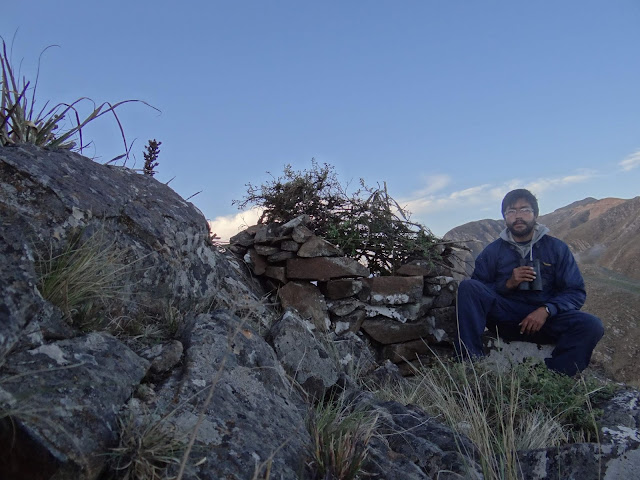Posted by Diego Mendez and Huw Lloyd
In a new research funded by the Peregrine Fund, The British Ornithological Union, The Neotropical Bird Club and MMU, MSc student Diego Mendez has shown that it is possible to individually identify Andean Condors Vultur gryphus on the basis of selected natural markings through the examination of photographs of perched and flying birds. More importantly, Diego’s research reveals that Andean Condor populations in Bolivia are still reasonably large. However, the population structure may be skewed toward male and sub-adult birds, with fewer females being present within the Bolivian population.
 |
Adult male
Condor sunbathing, Reserva Nacional de Fauna y Flora
Tariquía, Bolivia (Photo: Diego Mendez).
|
Surveying condors using a ‘capture-recapture’ photographic method
Between July and December 2014, Andean Condors were surveyed at 28 different locations (which we called survey feeding stations) throughout the eastern Andean region of Bolivia, encompassing the high-Andean vegetation, semi-humid puna, inter-Andean dry forest, Bolivian-Tucuman forest and Chaco Serrano ecoregions in the Cordillera Oriental and Subandino. Condors were attracted to each feeding station using equine carcasses that had been obtained humanely.
 |
| Diego at photographic blind waiting for Condors to show up. |
At each feeding station, condors were photographed from 7 am to 6 pm whilst they fed at the carcasses. Photos were taken from newly constructed observation hides positioned 35-100 m from the animal carcass to permit optimal viewing of feeding and flying condors. To photograph condors, Diego and his field assistants used a digital camera mounted on a digiscoping adaptor attached to an 82 mm-objective spotting scope with a 20-60 magnification eyepiece, plus one or two bridge cameras with lenses with focal distances of up to 810-1550 mm.
 |
| Juvenile female Condor, Parque Nacional Torotoro, Bolivia (Photo: Diego Mendez). |
The team took as many photographs as possible aiming to get high quality photographs that clearly showed both flanks of perched adult condors (head and body for males) and fully extended flying and tail feathers of condors in flight. By the end of the surveys, Diego and his team managed to take over 21,000 photographs of Andean Condors, of which nearly 8,000 (37%) were judged to be usable for condor identification.
A total of 566 condors were recorded from all survey feeding stations. From these data, Diego identified 456 different individuals, including 134 adult males, 40 subadult males, 79 juvenile males, 80 adult females, 30 sub-adult females and 93 juvenile females. Thus, the minimum population count for the Andean Condor population was 456 individuals with a population structure composing of adults, sub-adults and juveniles. Closed population capture-recapture homogeneity modelling produced a population estimate of 1,222 ± 99 (SE) condors. This estimate encompasses the population to the eastern Andes of central and southern Bolivia including the Apolobamba Mountains, an area of approximately 42,000 sq km.
 |
| Juvenile male Condor flying, Parque Nacional Torotoro, Bolivia (Photo: Diego Mendez). |
References
Arshad, M., Chaudhry, M.J.I. & Wink, M. (2009). High mortality and sex ratio imbalance in a critically declining Oriental White-backed vulture population (Gyps bengalensis) in Pakistan. Journal of Ornithology 150: 495-503.
Lambertucci, S.A. (2010). Size and spatio-temporal variations of the Andean condor Vultur gryphus population in north-west Patagonia, Argentina: communal roosts and conservation. Oryx 44: 441-447.
Méndez, D.R., Soria-Auza, W.R., Vargas, F.H. & Herzog, S.K. (2015). Population status of Andean Condors in central and southern Bolivia. Journal of Field Ornithology 86: 205-212.
Ríos-Uzeda, B. & Wallace, R.B. (2007). Estimating the Size of the Andean Condor Population in the Apolobamba Mountains of Bolivia. Journal of Field Ornithology 78: 170-175.
Acknowledgements
Diego's work is part of Proyecto Cóndor Andino - Asociación Armonía and has been supported by




No comments:
Post a Comment